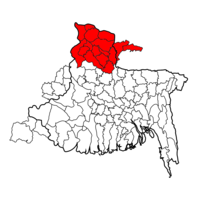Rangpuri language
| Kamtapuri | |
|---|---|
| Rajbangshi (India) Kamtapuri (India) Kamtai (India) Rangpuri (Bangladesh) Rajbanshi (Nepal) | |
 | |
| Native to | Bangladesh, India, Nepal |
Native speakers | 15 million (2011)[2] |
| Eastern Nagari (Official in Bangladesh, Assam and West Bengal) Devanagari (rare uses) | |
| Language codes | |
| ISO 639-3 | Variously:rkt – Kamta/Rangpurirjs – Rajbanshikyv – Kayort[1] |
| Glottolog | rang1265 Rangpurirajb1243 Rajbanshi |
Kamtapuri, Rangpuri or Rajbangshi is a Bengali-Assamese language spoken by the Rajbongshi people in Bangladesh and India, and Rajbanshi and Tajpuria in Nepal. Many are bilingual in either Bengali or Assamese.
Names
Rangpuri goes by numerous names. In Bangladesh, these include Rangpuri, Bahe Bangla, Ancholit Bangla, Kamta, Polia. In India, there is Kamtapuri, Dutta, Rajbangsi, Rajbansi, Rajbanshi, Rajbongshi, Goalparia, surjapuri, Koch Rajbanshi. Another name of the language is Tajpuri. In Assam it is known as Kochrajbongshi. In Bihar it is known as Surjapuri.
Dialects
The main dialects are Western Rajbanshi, Central Rajbanshi, and Eastern Rajbanshi.
The Central dialect has the majority of speakers and is quite uniform. There are publications in this language. The Western dialect has more diversity. Lexical similarity is 77 to 89% between the three dialects. Rajbonshi shares 48 to 55% of its vocabulary with Assamese and Bengali and 43 to 49% with Maithili and Nepali.
Comparison with Kamtapuri, Bengali, Assamese and Sylheti language
| English | Kamtapuri/Koch Rajbanshi | Assamese | Bengali | Sylheti | |
|---|---|---|---|---|---|
| I do | Muĩ kôrû | Môi kôrû | Ami kôri | Mui/Ami xori | |
| I am doing | Muĩ kôridhorchung | Môi kôri asû | Ami kôrchi | Mui/Ami xoriar/xorram | |
| I did | Muĩ kôrchulung | Môi kôrisilû | Ami kôrêchilam | Mui/Ami xorslam | |
| I was doing | Muĩ kôridhorchulung | Môi kôri asilû | Ami kôrchilam | Mui/Ami xorat aslam | |
| I will do | Muĩ kôrim | Môi kôrim | Ami kôrbo | Mui/Ami xormu | |
| I will be doing | Muĩ kôrtê thakim | Môi kôri/kôrat thakim | Ami kôrtê thakbo | Mui/Ami xorat táxmu |
Notes
- ^ Hammarström (2015) Ethnologue 16/17/18th editions: a comprehensive review: online appendices
- ^ Kamta/Rangpuri at Ethnologue (18th ed., 2015) (subscription required)
Rajbanshi at Ethnologue (18th ed., 2015) (subscription required)
Kayort[1] at Ethnologue (18th ed., 2015) (subscription required)
References
- Toulmin, Mathew W S (2006). Reconstructing linguistic history in a dialect continuum: The Kamta, Rajbanshi, and Northern Deshi Bangla subgroup of Indo-Aryan (Ph.D.). The Australian National University.
{{cite thesis}}: Invalid|ref=harv(help)
